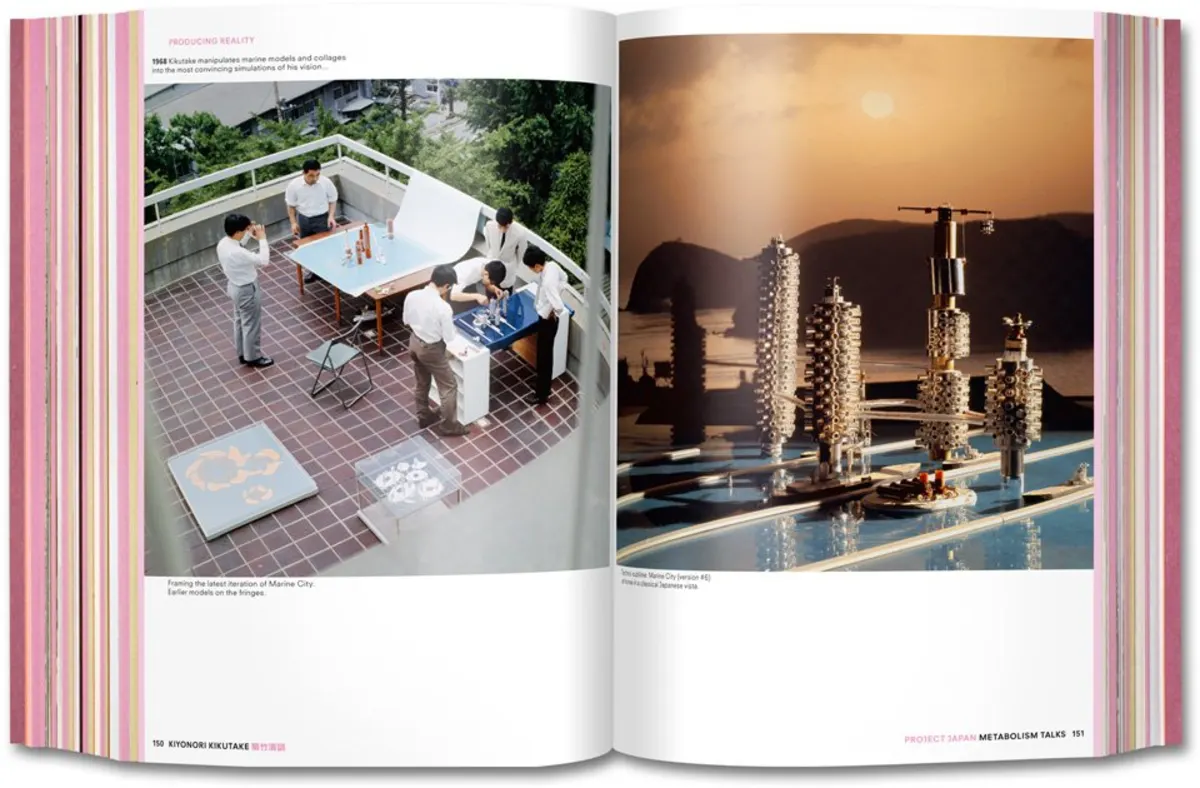1 / 8
Koolhaas/Obrist. Project Japan. Metabolism Talks
70
L'architetto Rem Koolhaas e il curatore Hans Ulrich Obrist elaborano una storia del Metabolismo: la prima architettura d'avanguardia non occidentale, nata nella Tokyo del dopoguerra. Ampie interviste e rare fotografie introducono il movimento e fanno luce sulla visione futuristica del gruppo: il sogno di città che crescono, si riproducono e si trasformano in risposta al loro ambiente.
Softcover, 6.7 x 9.2 in., 2.96 lb, 720 pagine

Koolhaas/Obrist. Project Japan. Metabolism Talks
70Back to the Future
Visionary architecture in postwar Japan
“Once there was a nation that went to war, but after they conquered a continent their own country was destroyed by atom bombs... then the victors imposed democracy on the vanquished. For a group of apprentice architects, artists, and designers, led by a visionary, the dire situation of their country was not an obstacle but an inspiration to plan and think... although they were very different characters, the architects worked closely together to realize their dreams, staunchly supported by a super-creative bureaucracy and an activist state... after 15 years of incubation, they surprised the world with a new architecture—Metabolism—that proposed a radical makeover of the entire land... Then newspapers, magazines, and TV turned the architects into heroes: thinkers and doers, thoroughly modern men… Through sheer hard work, discipline, and the integration of all forms of creativity, their country, Japan, became a shining example... when the oil crisis initiated the end of the West, the architects of Japan spread out over the world to define the contours of a post-Western aesthetic....” —Rem Koolhaas / Hans Ulrich Obrist
Between 2005 and 2011, architect Rem Koolhaas and curator Hans Ulrich Obrist interviewed the surviving members of Metabolism—the first non-Western avant-garde, launched in Tokyo in 1960, in the midst of Japan’s postwar miracle. Project Japan features hundreds of never-before-seen images—master plans from Manchuria to Tokyo, intimate snapshots of the Metabolists at work and play, architectural models, magazine excerpts, and astonishing sci-fi urban visions—telling the 20th-century history of Japan through its architecture.
From the tabula rasa of a colonized Manchuria in the 1930s, a devastated Japan after the war, and the establishment of Metabolism at the 1960 World Design Conference in Tokyo to the rise of Kisho Kurokawa as the first celebrity architect, the apotheosis of Metabolism at Expo ’70 in Osaka, and its expansion into the Middle East and Africa in the 1970s: The result is a vivid documentary of the last moment when architecture was a public rather than a private affair.
Further reading
Between 2005 and 2011, architect Rem Koolhaas and curator Hans Ulrich Obrist interviewed the surviving members of Metabolism—the first non-Western avant-garde, launched in Tokyo in 1960, in the midst of Japan’s postwar miracle. Project Japan features hundreds of never-before-seen images—master plans from Manchuria to Tokyo, intimate snapshots of the Metabolists at work and play, architectural models, magazine excerpts, and astonishing sci-fi urban visions—telling the 20th-century history of Japan through its architecture.
From the tabula rasa of a colonized Manchuria in the 1930s, a devastated Japan after the war, and the establishment of Metabolism at the 1960 World Design Conference in Tokyo to the rise of Kisho Kurokawa as the first celebrity architect, the apotheosis of Metabolism at Expo ’70 in Osaka, and its expansion into the Middle East and Africa in the 1970s: The result is a vivid documentary of the last moment when architecture was a public rather than a private affair.
- Oral history by Rem Koolhaas and Hans Ulrich Obrist
- Extensive interviews with Arata Isozaki, Toshiko Kato, Kiyonori Kikutake, Noboru Kawazoe, Fumihiko Maki, Kisho Kurokawa, Kenji Ekuan, Atsushi Shimokobe, and Takako and Noritaka Tange
- Hundreds of never-before-seen images, architectural models, and magazine excerpts
- Layout by award-winning Dutch designer Irma Boom
Further reading
I editori e gli autori
Hans Ulrich Obrist es el Codirector de Exposiciones y Programas y Director de Proyectos Internacionales de la Serpentine Gallery, Londres.
Rem Koolhaas is a co-founder of the Office for Metropolitan Architecture. Having worked as a journalist and scriptwriter before becoming an architect, in 1978 he published Delirious New York. His 1996 book S,M,L,XL summarized the work of OMA and established connections between contemporary society and architecture. Among many international awards, he has received the Pritzker Prize (2000) and the Praemium Imperiale (2003).
Koolhaas/Obrist. Project Japan. Metabolism Talks
Softcover, 17 x 23.3 cm, 1.34 kg, 720 pagineISBN 978-3-8365-2508-4
Edizione: IngleseScarica qui le immagini del prodotto
5
Fantastic book about Japanese Metabolism movement and more.
4 novembre 2021
Koolhaas does a very detailed report on Metabolism, a not so well known japanese architecture movement. It includes interviews and a large amount of photos and drawings. Very informative on the origins and development of Metabolism, but also works as an historic reference to progressive urban design of the time and its influence on contemporary thinking on this subject. Apart from the theme, I also found the book has an interesting design and is beautifully produced. Five stars indeedIncreible
2 novembre 2021
Un libro impecable, desde su impresión hasta el contenido. El movimiento metabolista japones ahora tiene un libro que debería haber tenido hace mucho.Japanese Architecture at its best
27 ottobre 2021
I found this book extremely informative and engaging. The drawings capture the complexity of the work involved in Metabolism Architecture. I highly recommend it!







